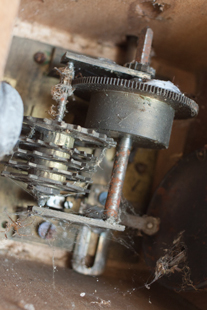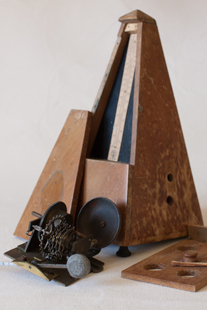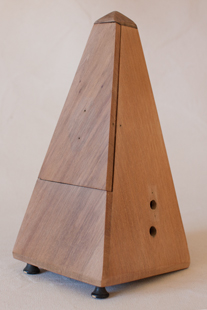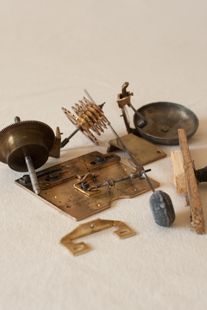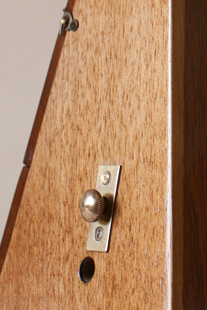 |
What we undertake:
Occasionally we purchase antique metronomes with the intention
of undertaking a rework of sorts depending on the current state
of the unit in question. The process can involve anything from a
full over-haul, including the replacement of missing or broken
parts, to full mechanism replacements or in the majority of
cases just a rework of the exterior woodwork. We encounter a
large number of original metronomes that are fully functioning
but have suffered through neglect or poor storage externally,
metronomes that are not up to our high standard's to be able to
list on the website.
This page is intended to hopefully give an insight into the procedure and
some of the issues that we regularly encounter and to show the
results from start to finish. Of course every metronome we
rework is assessed and a course of action determined depending
on the particular metronomes faults but hopefully this one
example should be a good representative example of restoring a
unit that otherwise would be destined for parts or scrapped. Our
REWORKED metronomes are clearly listed on the metronomes
description page.
Hold your mouse pointer over a gallery image for an
enhanced zoom, or click 'play' to listen to your selected
metronome.
Paquet Cherry Wood Metronome - Attic / Loft Find in Poor Condition. - Circa 1919
This one came to us in non-working order and
was externally water damaged from poor storage in a damp loft, this
metronome left us with no choice but to fully strip the entire
metronome. The original parts and fittings are all in place,
with the lower slat and rear foot damaged, the bell and
mechanism escapement are both completely seized or not working,
partly with thanks to the wildlife living within the mechanism
compartment. Fortunately there is no wood-worm damage or major
splits or chips to the woodwork. ( Pictures 1-4 )
We start by removing all external fittings and the door emblem, hinge etc and
removing the mechanism from the housing compartment. All loose
debris and years of dust and grime are lightly removed with a
fine soft bristle brush from all parts of the external casing
and the mechanism. ( Picture 4 ). The external case / woodwork
is sanded from a medium grit right down to 0000 steel wool. (
Picture 5 ). The mechanism is completely disassembled, we will
not go into our procedure for cleaning the critical
parts of the movement and escapement as I could fill the page
with technicalities and each part requires different techniques,
however as this mechanism was particularly bad, a lot of the
parts did require a lot of hand polishing, degreasing, acid bath
and ultra-sonic cleaning. The original wooden rear slat re-glued
and a brace added for support that is hidden from view when
reassembled. ( Picture 7 ). The bell assembly is stripped and
critical parts polished and greased, the bell hammer readjusted and spring
re-tensioned. Once we are confident that all parts are moving
freely, and that all grease, old oiling attempts and lamp oil or
coal fire residue are removed, we reassemble the mechanism. (
Picture 8 ).
External Woodwork - VARIES ( Tru-Oil used on this example ) & Reassembly
Each metronome we select for rework is carefully assessed prior
to undertaking any work, this includes the existing external
woodwork and deciding the best course of action on things such
as how dry the wood is, wood grain, physical damage, water
damage, the status of any stains applied, whether it is an open
grained wood, scratches or gouges etc, before deciding what in
our opinion would be the best overall finish for each particular
metronome. While we do not get it right all of the time, we do
enjoy the process and lets face it, anything is better than how
this 99 year old metronome looked when we received it. Our
finishing is largely dependant on the original look of each
individual unit and on the age of the metronome. These include,
Danish and Tung Oils, Tru Oil ( used initially for gun stocks ),
varnish, stains and sealers, wax and in some cases such as
Walnut and Rosewood, 'Au Naturale'.
Having sanded the exterior to a very fine, silky base it became
evident that this particular metronome was quite unique ( Paquet
had a habit of selecting and constructing wonderful wood panels
with lovely grain and then covering it up or masking it, with
the external finish ) it has quarter sawn Cherry side panels,
both the left and right and standard cut Cherry front and back
panels, this results in an almost two toned appearance to the
overall look of the metronome. Whilst this may not be to
everybody's taste ( Paquet included ), we liked it and went with
just an oil, no stains, no sealers other than wet sand to fill
the pores. Seven coats in total. over the course of 3 days with
light abrasion with 0000 steel wool between the first 3 coats.
The result is a semi-gloss / gloss or polished appearance that
still retains an antiqued appearance,
durable, water-resistant and no finger marks or handling
evidence, it also has the bonus or being very easy to reapply in
the future should the metronome become scratched or worn and is
far more forgiving than a varnished finish for example. The
external brass fittings on this particular metronome have been
polished and reinstalled once the woodwork finish had properly
cured. The lower slat and rear foot repaired and felt added to the feet
bases. ( Picture 13 ).
The mechanism is replaced and we begin the process of balancing
and testing ( 3 Days ) to ensure the unit is performing within
our tolerance of +/- 5 beats per minute. This metronome
performed very well achieving 60 bpm for a total runtime of 45
minutes. The bell operating correctly but only on two of the four settings.
We hope you enjoy the results as much as we enjoyed undertaking
the transformation and hopefully given an insight into the work
involved and timeframes required.
Have one destined for the skip?
We are always interested in
purchasing Antique metronomes considered beyond repair or
destined to be discarded. We do require that the mainspring
operates and this can be determined by dropping us an email for
instructions or help on how to confirm this. The metronome would
also need to be salvageable, i.e not run over by a truck. Please
do not expect us to pay silly prices due to the work involved in
restoring poor quality metronomes, we will require quality
pictures to include the mechanism and a brief description of any
known issues or faults if possible. We do not purchase metronomes
post 1940. Thanks for reading!.
Brass Polishing:
We also offer a brass polishing service, where we remove all exterior brass fittings and polish to a high sheen which seems to be popular when matching a metronome to a piano for display purposes. We do not clean the fittings by default unless we feel the unit warrants it and any item shown on the website without cleaned brass-work is sold as viewed. We will however, under instruction polish fittings once a unit has been purchased for a standard charge of £9.95. Occasionally metronomes can be fitted with nickel silver or copper metal-work and in most cases these are best left to develop a deep handling patina. We will advise if we do not think that a unit would benefit from this service.








